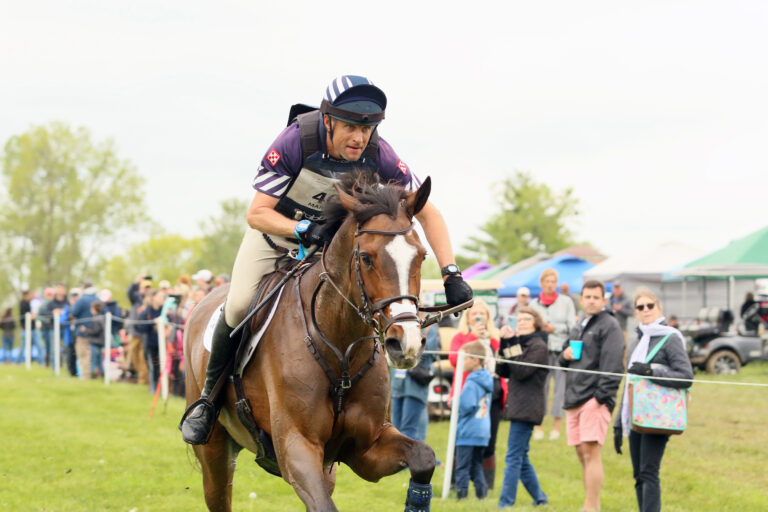If you’re an eventing fan, you’ve probably noticed horses, especially on cross country, sporting those little strips just above their nostrils that almost look like stickers, medical tape or big Band-Aids. But these often brightly colored patches do more than add decoration or logo display.
Developed by a team of veterinarians, FLAIR Equine Nasal Strips help support the soft tissues over a horse’s nasal passages to reduce airway resistance and improve airflow when more oxygen is needed during increased physical activity. Due to the intense nature of eventing, many top riders in the sport utilize the strips, especially on cross country and sometimes also in dressage and show jumping.

“At least eight studies have been conducted over the past decades to show exactly how nasal strips work,” Howard H. Erickson, DVM, PhD, emeritus professor of physiology and history of veterinary medicine at the Kansas State University College of Veterinary Medicine in Manhattan, Kansas, noted. “And there are more than a dozen publications that support their effectiveness in reducing exercise-induced pulmonary hemorrhage.”
Overall, the strips work to help reduce stress on a horse’s respiratory system, allowing more oxygen to be delivered to muscle tissues, which prolongs the onset of fatigue and provides for faster recovery after intense exercise. We’ll explain more about how these small, but mighty strips work to determine if your horse might benefit from their technology.
How Nasal Strips Work
During exercise, especially when intense, horses experience some level of nasal tissue collapse, which reduces the size of their airways and forces them to work harder to breathe. When applied about an inch and a half above a horse’s nostrils, nasal strips help stabilize the nasal passages which allows oxygen to flow more freely.
“The strips use three plastic support members to apply a springlike force that gently supports the soft tissue overlaying the nasal passages during inspiration, particularly where the nasal passages are not supported by bone,” Erickson explained.

Once breathing is made easier, horses don’t tire as quickly and are able to conserve more energy more efficiently. Eventers also often keep the strips on during their horses’ cooldowns because when air can move in an out more easily, horses will cool down and recover quicker.
In addition to helping upper-level sporthorses who regularly compete in high-intensity sports, nasal strips can also offer benefits to those competing at lower levels of competition. Lower-level equine athletes often aren’t as fit as their more athletic, upper-level counterparts and therefore may have to work harder to do the same job and experience longer recovery times. Improving airflow can equally help these horses do their jobs more easily.
Nasal strips can also be helpful for:
- Horses suffering from seasonal allergies
- Horses with laryngeal hemiplegia (“roaring”)
- During long trailer hauls when horses are more exposed to more pollutants and stale or dusty air conditions
- Horses with lower-airway disease
Understanding the Equine Respiratory System
The equine respiratory system is designed to transfer large volumes of air in and out of the lungs during exercise to fuel the body’s many processes and can be separated into two parts: the upper and lower airways. The upper airway begins at the nostrils, extends through the larynx and into the trachea. The lower airway includes the massive lungs, which extend from underneath the shoulder muscle up the back and close to the far end of the rib cage. A normal horse will take around 12 breaths per minute at rest, but his respirations may reach more than 100 breaths per minute during strenuous exercise.
Several types of physical malfunctions, infections and diseases can negatively impact the effectiveness of the respiratory system. Many of them can be treated through medication or prevented with vaccinations, but the number-one method of managing your horse’s respiratory health is providing a clean, healthy living environment
Reduce Exercise-Induced Pulmonary Hemorrhage
Exercise-induced pulmonary hemorrhage (EIPH) is a disease that affects horses undergoing extreme or intense exercise like racing or high-level jumping. Horses suffering from EIPH are commonly referred to as “bleeders” because the disease causes small blood vessels to rupture within the lungs. Sudden decreased performance may be a strong indicator of the condition and can be confirmed through an upper-airway scope or a bronchoalveolar lavage (lung wash) procedure.
While the American College of Veterinary Internal Medicine’s consensus published by the Journal of Veterinary Internal Medicine in 2015 noted that there is some evidence that furosemide (a diuretic commonly called Lasix) administered four hours before strenuous exercise “decreases the severity and incidence of EIPH,” there are no reports of effective treatment.

“It is technically an incurable disease, so the best prescription is a less-intense career,” Lisa Fultz, DVM, MS, DACVIM, an internal medicine specialist from Equine Medicine Specialists of South Florida, explained. “The more it happens, the less pliable and healthy the lung becomes. The injury/heal cycle also leads to scarring of the vessels so they become less effective at air exchange and more likely to reinjure.”
In addition to lessening the intensity of the horse’s work load, Fultz says managing the environment to minimize allergens and irritants will help keep respiratory cells healthy. Easier breathing also reduces stress on the fragile pulmonary blood vessels in the lungs, resulting in fewer ruptured pulmonary blood vessels. And by improving air flow, nasal strips can help prevent pulmonary capillary membranes from rupturing during exercise.
Regulations on Nasal Strips
When it comes to competition rules, it’s always best to check directly with your organization’s governing body for rule updates, as they can periodically change. At the time this article was published, the following organizations have approved the use of FLAIR Nasal Strips:
- Federation Equestre Internationale (FEI)
- US Equestrian (formerly American Horse Shows Association, AHSA)
- United States Eventing Association (USEA)
- United States Equestrian Team Foundation (USET)
- American Quarter Horse Association (AQHA)
For More:
- To read more about equine respiratory disease and health, click here.
- Learn more about equine asthma and new treatment options here.
- Can’t get enough of eventing? We’re counting down to our favorite event of the year—2025 Defender Kentucky Three-Day Event. Click here for more of our coverage of this year’s event.
- Check out hands-on training advice and top tips from one of our favorite eventers Jennie Brannigan in her video series on EQUESTRIAN+.
Thanks to Kent Nutrition Group and Blue Seal for our coverage of the 2025 Defender Kentucky Three-Day Event, including lead-up events, rider interviews, competition reports, horse spotlights, photos, videos and more!












